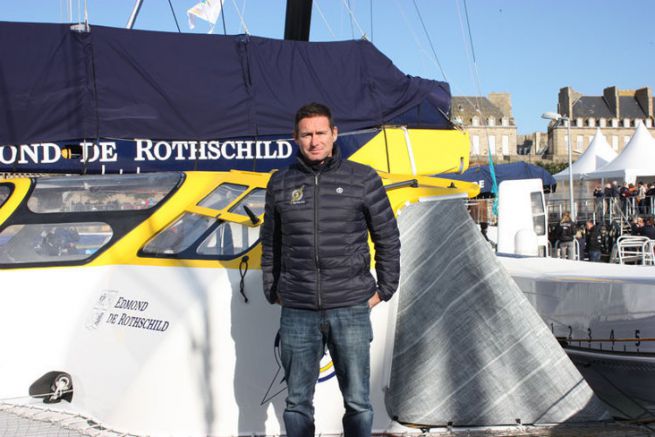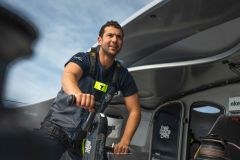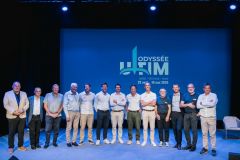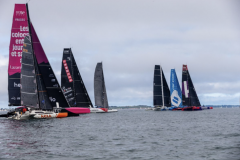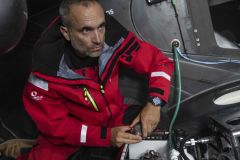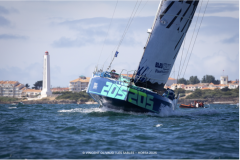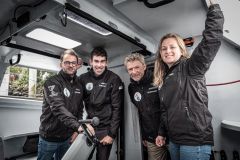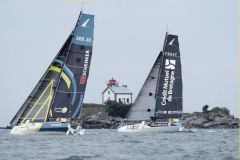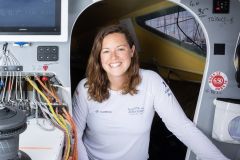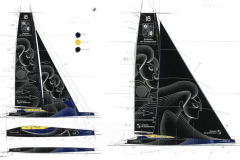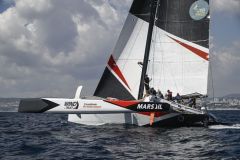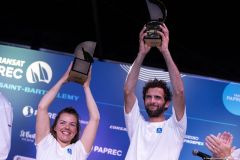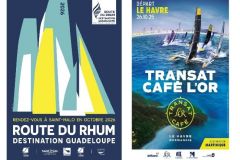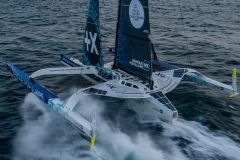What is the outcome of your 2018 season since the Transat Jacques Vabre?
During the Jacques Vabre we wiped the casts of a young and innovative boat. We've been working all winter to fix all these defects. It's not easy because it's a big boat. There are things that seem very simple to manage and clarify, but in the end, they are not when it comes to finding solutions. We pedaled a little in the semolina for the first few months of the launch this year. We couldn't find a solution. To give you an idea: we sailed for a day and spent two weeks on site. But as we went along, we finally moved on. At the end of the year, there was no more construction site. This is a good sign, even if on the Route du Rhum we may have some minor damage. It's part of the game. For example, the appendixes still vibrate, when it vibrates it degrades and when it degrades it flies less well.
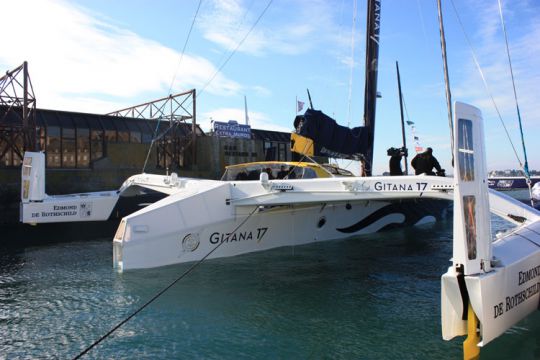
What changes have been made to the trimaran?
We have not made any major changes. We just erased all the mistakes we saw in the Jacques Vabre style. We still destroyed both foils. The same foils were identical, but mechanisms were studied to block them. They were moving a few millimetres and 40 knots when the windward foil hits the water and it moves 2mm, it's like a hammer hit. It's not for that!
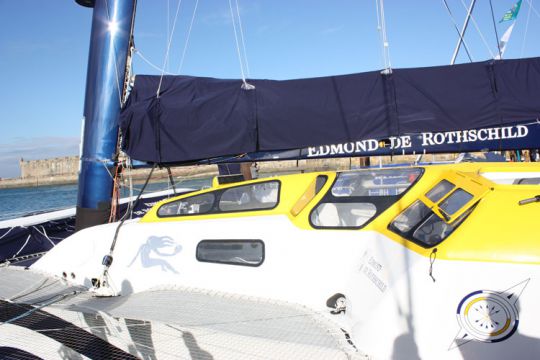
For what wind conditions and angles are the foils studied?
Our foils are very versatile. The boat is designed to go very fast at all speeds, from meadows to downwind. To give you an idea: upwind on the Jacques Vabre, we were making 20-22 knots, we had the impression that we were going fast. Today we are between 25 and 27 knots at the same speed. We've gained five knots! Because we sail better with the boat, we tune the sails and appendages better. It is only the hours of sailing that make it possible to get there. It matches the boat's theoretical targets. On paper, upwind, we should be able to reach 28 knots and fly.
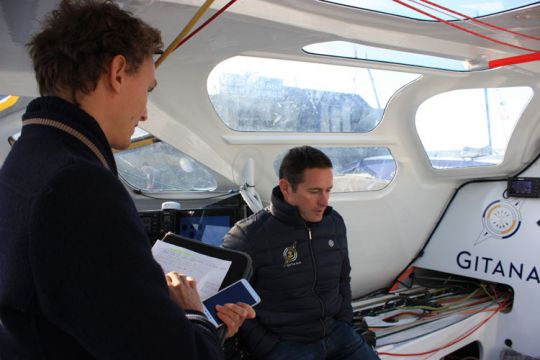
Is the boat 100% optimized?
Frankly, he's close to it. The end of the year was very productive. We sailed with François[Gabart] and Armel[Le Cleac'h]. François still has THE fastest boat, but we are reassured that we can go fast too.
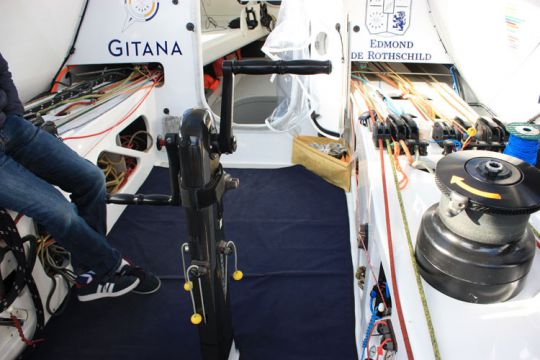
How is life on board such a machine?
You spend your time on the columns! Your role as skipper is like that of the merchant navy: there are actions to be done. These actions take time X. For example, a tack change is 27 minutes, sending it from the gennaker 48 minutes... So for 48 minutes your only added value is to turn the cranks. Meanwhile there is no notion of piloting, no notion of being a good sailor or not, you just have to turn the cranks!
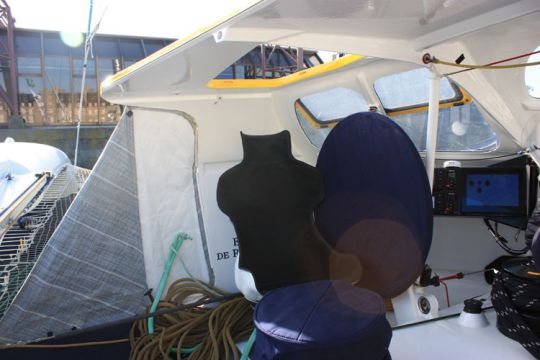
Can you relax when you fly at 40 knots?
Today not much because we discover it. We don't have enough flight hours. When I have two seasons with this boat, a round the world trip, a Route du Rhum and everything goes well, it will become natural. For this Route du Rhum, I risk being a little tense during the 7 days of the race. François will certainly be less tense than I am. He sailed around the world alone on his boat, Thomas the same way. Armel and I have less luggage.
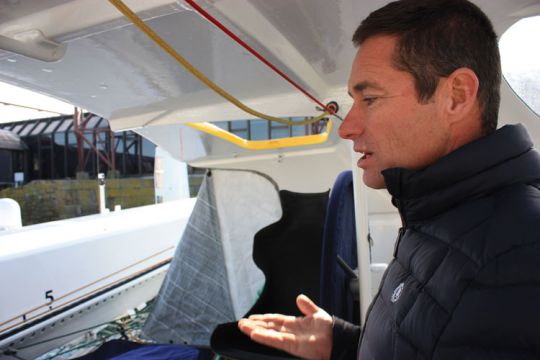
Can you enjoy it and have moments of pleasure?
I'm taking advantage of it post-navigation. Once you've arrived, the boat is docked and we haven't embossed on the pontoon. Now I'm relieving myself. At the end of the Jacques Vabre I realized: I crossed the Atlantic in 7 days. I was able to look back. During the race we realize that we go fast, every day we change countries: one morning you are in Spain, the next day in Morocco, the next day in Cape Verde... you realize that it is happening. But we remain focused on the fact that we have to stay upright. It's only after you realize it's crazy what's going on. Finally you experience our navigation live, while we rediscover it 8 days later.
Can you tell us about a memorable experience on board this boat?
It's the discovery of the boat. Two weeks ago, we were with Nicolas Lunen at night "drinking coffee", we were well at 42 knots. We thought the boat was stable and nice. When we were going down to 39 knots we were slow. Just because it happens fast doesn't mean we're stressed all the time. That's reassuring. Theft is not a source of danger. When you fly stable without being overloaded, it's like going fast in a sedan. That's what it's for. I think it's better that the boat is sitting on its foils flying and that it still has to fly rather than go up and down. When it decelerates, it hits the water, the boat is shaken.
Can you introduce us to the boat, give us a tour?
It's "very small"! [NDLR the platform measures 32m by 23m wide!]. Here we are in the manoeuvring area, with the helm - but we no longer steer the boats because when we steer we only take care of the steering. But we the direction don't care, what we want is to get out of the water. What we manage above all is the take-off and maintenance of the wind. From now on, this is what it means to sail a boat. Before we used to watch the waves, the laughs... now we don't care, all that rule in the flap. Sails are the engine, you put 100% of the rpm: the adapted surface and we adjust it according to the marks. Once the engine is in block, this power is managed with flaps that are controlled manually with the valves. There are 4 supports: first you raise the boat, we take off without raising it too high. Once the desired height is reached, you push the back to stabilize it. Like a plane.
My life is going to be mostly in this area. Not much forward because we're too far from the manoeuvring centre. Everything comes back to the cockpit, I never have to go out separately to put the gennaker: put the tack, the halyards but it lasts 4 minutes.
I'll sleep in the seat, or I'll put the mattress here in bulk. On the Route du Rhum the pace will be intense, very short. When we go to sleep, we adjust the boat so that it is a little less fickle. On a Route du Rhum, you take your foot off the gas in these moments, you don't want to turn around.
Inside, in the hull there is nothing: engine room, engine, batteries, electronics. The sails are stored on deck. A sail bag is 150 kg. It doesn't come out from the inside, it doesn't matt, it stays on the net. It's hard enough to move it on the net. It remains at the boat's centre of gravity. We take on as little sail as possible. Nothing is not imposed. Depending on the weather conditions we will leave with: a gennaker and two meadowsails. Sails are versatile. There may be 10° of real wind angle between 125° and 135° where you don't really know what to wear, but who cares? With these boats you extend the edge by 5 minutes and we're there. We're going so fast that by the time we do the manoeuvre, we'd be 125° from the wind again. What you always have to be at 40 knots. In MOD we also lacked an intermediate sail. Sometimes we'd pass the layline downwind, we'd drive and get back on the fast angle and you'd fuck the guy who was trying to make the intermediate route. While you've done a third more drive, but four times faster
Since we don't move the sails to adjust the trim, today we adjust the incidence of rudders. When there are 3 degrees of incidence on the rudder it helps to take off, but it is also a brake. We'd like to sail with 0.5°. That means we could move the weight to remove the incidence. But today we are not there yet. We are at the very beginning of the boat's progress.
In two months we have made phenomenal progress. When you change a setting, you gain 3 knots. It's incredible and it's just the beginning.
The boat was designed around the foils. What does this imply from an architectural point of view?
The shapes of the floats are very flat to help with take-off. But the most striking thing is the size of the appendages. Between those of Banque Populaire and ours, they are twice as big, therefore twice as heavy, but also twice as efficient at low speeds. A flying boat is not necessarily a light boat. The structure could not be lighter. For a boat to fly well and be stable, the platform must be very rigid. You can't play at half a degree of incidence on a rudder if the platform deforms by 4°. It is a whole. The structure is armoured, the arms are huge. The boat is steep. If you're flying at 40 knots, it all has to be frozen. If it deformed like the forward trimarans that were "twisting", the incidence would change and we couldn't fly stable. It has to be a beam, but it's expensive on the scale.

